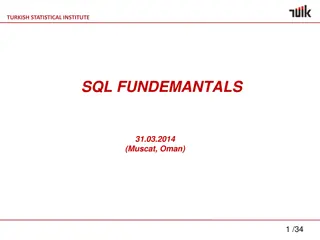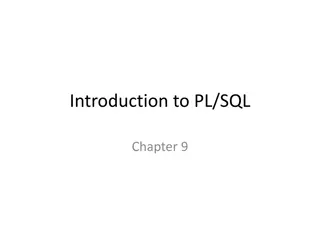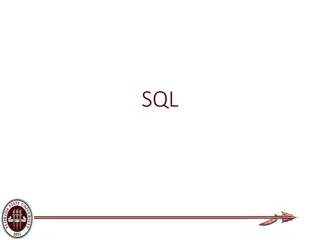
SQL Commands and Examples for Efficient Database Management
"Explore a comprehensive list of various SQL commands for managing relational databases efficiently. Learn about creating tables, altering structures, using operators like AND, aggregate functions like AVG, and more."
Download Presentation

Please find below an Image/Link to download the presentation.
The content on the website is provided AS IS for your information and personal use only. It may not be sold, licensed, or shared on other websites without obtaining consent from the author. If you encounter any issues during the download, it is possible that the publisher has removed the file from their server.
You are allowed to download the files provided on this website for personal or commercial use, subject to the condition that they are used lawfully. All files are the property of their respective owners.
The content on the website is provided AS IS for your information and personal use only. It may not be sold, licensed, or shared on other websites without obtaining consent from the author.
E N D
Presentation Transcript
List of verious sql commands Subject RDBMS
List of SQL Commands SQL, Structured Query Language, is a programming language designed to manage data stored in relational databases. SQL operates through simple, declarative statements. This keeps data accurate and secure, and it helps maintain the integrity of databases, regardless of size.
SOME COMMANDS: CREATE TABLE Syntax CREATE TABLE table_name ( column1 datatype, column2 datatype, column3 datatype, .... ); Continue to next slide,
SQL CREATE TABLE Example The following example creates a table called "Persons" that contains five columns: PersonID, LastName, FirstName, Address, and City: Example CREATE TABLE Persons ( PersonID int, LastName varchar(255), FirstName varchar(255), Address varchar(255), City varchar(255) );
ALTER TABLE Example: ALTER TABLE table_name ADD column_name datatype; ALTER TABLE lets you add columns to a table in a database.
AND command SELECT column_name(s) FROM table_name WHERE column_1 = value_1 AND column_2 = value_2; AND is an operator that combines two conditions. Both conditions must be true for the row to be included in the result set.
AVG() SELECT AVG(column_name) FROM table_name; AVG() is an aggregate function that returns the average value for a numeric column.
BETWEEN SELECT column_name(s) FROM table_name WHERE column_name BETWEEN value_1 AND value_2; The BETWEEN operator is used to filter the result set within a certain range. The values can be numbers, text or dates.
CASE SELECT column_name, CASE WHEN condition THEN 'Result_1' WHEN condition THEN 'Result_2' ELSE 'Result_3' END FROM table_name; CASE statements are used to create different outputs (usually in the SELECT statement). It is SQL s way of handling if-then logic.
COUNT() SELECT COUNT(column_name) FROM table_name; COUNT() is a function that takes the name of a column as an argument and counts the number of rows where the column is not NULL.
DELETE DELETE FROM table_name WHERE some_column = some_value; DELETE statements are used to remove rows from a table.
GROUP BY SELECT column_name, COUNT(*) FROM table_name GROUP BY column_name; GROUP BY is a clause in SQL that is only used with aggregate functions. It is used in collaboration with the SELECT statement to arrange identical data into groups.
HAVING SELECT column_name, COUNT(*) FROM table_name GROUP BY column_name HAVING COUNT(*) > value; HAVING was added to SQL because the WHERE keyword could not be used with aggregate functions.
INNER JOIN SELECT column_name(s) FROM table_1 JOIN table_2 ON table_1.column_name = table_2.column_name; An inner join will combine rows from different tables if the join condition is true.
INSERT INSERT INTO table_name (column_1, column_2, column_3) VALUES (value_1, 'value_2', value_3); INSERT statements are used to add a new row to a table.
IS NULL / IS NOT NULL SELECT column_name(s) FROM table_name WHERE column_name IS NULL; IS NULL and IS NOT NULL are operators used with the WHERE clause to test for empty values.
LIKE SELECT column_name(s) FROM table_name WHERE column_name LIKE pattern; LIKE is a special operator used with the WHERE clause to search for a specific pattern in a column.
MAX() SELECT MAX(column_name) FROM table_name; MAX() is a function that takes the name of a column as an argument and returns the largest value in that column.
MIN() SELECT MIN(column_name) FROM table_name; MIN() is a function that takes the name of a column as an argument and returns the smallest value in that column.
OR SELECT column_name FROM table_name WHERE column_name = value_1 OR column_name = value_2; OR is an operator that filters the result set to only include rows where either condition is true.
ORDER BY SELECT column_name FROM table_name ORDER BY column_name ASC | DESC; ORDER BY is a clause that indicates you want to sort the result set by a particular column either alphabetically or numerically.






















